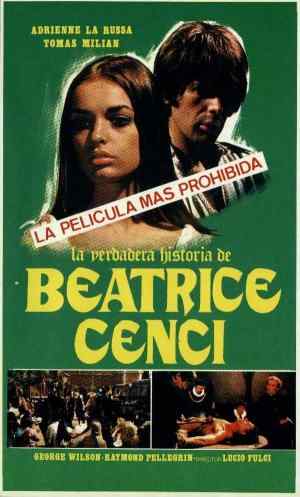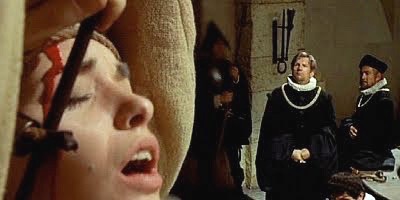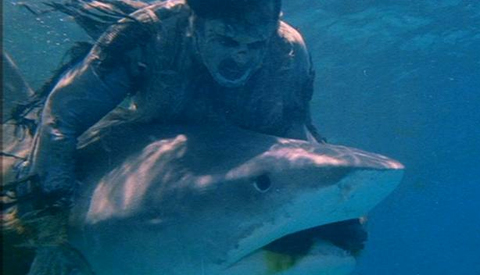 If Lucio Fulci had only directed the 1979 cult splatterfest Zombie, he would still warrant more than a footnote in any film history of the horror genre. Obviously inspired by the success of George Romero’s Night of the Living Dead and Dawn of the Dead, Fulci’s cult favorite pushed the zombie film into over-the-top excess with the famous eyeball-splinter scene and an underwater grudge match between a shark and one of the undead.
If Lucio Fulci had only directed the 1979 cult splatterfest Zombie, he would still warrant more than a footnote in any film history of the horror genre. Obviously inspired by the success of George Romero’s Night of the Living Dead and Dawn of the Dead, Fulci’s cult favorite pushed the zombie film into over-the-top excess with the famous eyeball-splinter scene and an underwater grudge match between a shark and one of the undead.
It also launched a whole new genre in the Italian film industry which included such imitators as Cannibal Apocalypse, Nightmare City and Erotic Nights of the Living Dead (all released in 1980). Fulci went on to further heights (or depths according to his detractors) with such supernatural thriller gross-outs as City of the Living Dead (1980), The Beyond (1981) and The House by the Cemetery (1981). But what most Fulci fans and film buffs tend to overlook is the fact that he was once a director who could occasionally turn out a thought-provoking and artful work of cinema such as his 1969 historical drama, Beatrice Cenci.
Also known as The Conspiracy of Torture, a much more telling description of the tragic events depicted, Beatrice Cenci is based on the real life 16th century woman whose cruel fate is legendary in Italy. Fulci may take poetic license with some of the historic details but the overall effect is a powerful and chilling anti-clerical expose which remains timeless as a cautionary tale about corruption among the power elite.
The film is also devoid of camp or sensationalized concessions to fans of softcore erotica or Sadian cinema unlike his later gore-drenched horror films. The torture scenes, in particular, are appropriately harrowing as they should be and not served up as ghoulish delights for grindhouse audiences as in Michael Armstrong’s Mark of the Devil (1970). In that regard you could say that the film functions as a grimly effective argument against the unconscionable and inhuman use of torture to force people to “tell the truth” or confess because it often results in false or unreliable information. Of course, in this instance Beatrice refuses to reveal anything but the lack of a confession doesn’t stop the prosecution from silencing the accused permanently.
What is most compelling about Beatrice Cenci is how Fulci handles the narrative, jumping back and forth in time creating a non-linear storyline where we are experiencing the events before and after they occur in such a way that actually increases the tension as we approach the dramatic highpoints of the story – the rape of Beatrice, her father’s murder and the attempts to disguise the crime as an accident.

Lucrezia Cenci (played by the actress Mavie) eyes her drugged husband Francesco (George Wilson) just prior to his murder.
The period detail, costumes and art direction are beautifully realized and Erico Menczer’s evocative color cinematography and an atmospheric score by Angelo Francesco Lavagnino and Silvano Spadaccino further enhance what is clearly one of Fulci’s most assured and tightly paced films.

Tomas Milian (far left) & Ignazio Spalla (far right) have appeared in several spaghetti westerns but in Beatrice Cenci they play servants who help their mistress in a murder scheme.
The film also boasts an exceptional cast and U.S. viewers will recognize many familiar character actors from other Italian and French genre films of the period such as Raymond Pellegrin (Le Deuxieme Souffle, Gang War in Naples) as Cardinal Lanciani and Ignazio Spalla (Johnny Hamlet, Sabata) as Catalano, one of Francesco Cenci’s assassins. In the title role of Beatrice is Adrienne Larussa, a strikingly beautiful American actress who mostly worked in television. She projects some of the dark allure of Barbara Steele in her role here as she transitions from helpless victim to determined avenger to a defiant prisoner whose face becomes an inscrutable mask by the end, revealing nothing under torture except pain. (Larussa’s other claim to fame is that she was formerly married to action hero Steven Seagal.)
Tomas Milian, who receives second billing as Beatrice’s lover and accomplice Olimpo Calvetti, is also effectively brooding and low-key in what is essentially a supporting character role. The scenes between Milian and Larussa alternate between tenderness and ambiguity; you’ve never quite certain if Olimpo is being used by Beatrice primarily to carry out her revenge or if their romance is genuine. Considering Olimpo’s sad fate and his silence before his punishers, you have to believe his love for Beatrice was undiminished to the end but her true feelings remain a mystery.

Tomas Milian is accused of murder in Beatrice Cenci (1969) but refuses to confess under extreme torture.
Easily the most memorable performance in the film is by George Wilson as Francesco Cenci. Without descending into melodramatic theatricality, he creates a convincing portrait of a loathsome tyrant who gives free reign to his appetites and urges with no fear of the consequences. Yet he is reduced to a pitiful figure, drugged and defenseless, in the film’s crucial murder scene – a violent death scene that could rival anything in Shakespeare’s MacBeth.
In the end, Beatrice Cenci works on several levels; as a historical procedural drama, a suspense thriller about a family in crisis and as a real life horror film with a scenario that could happen today.
Several aspects of the actual Beatrice Cenci case may never be known or proven. For example, there are no accounts or real evidence that she was raped or sexually abused by her father. But for those not familiar with the story, here is a rough outline of the famous murder case.

The perverse Count Cenci (George Wilson) threatens his daughter Beatrice (Adrienne Larussa) with physical abuse in the Lucio Fulci historical drama.
Beatrice, the daughter of the wealthy and powerful landowner Francesco Cenci, sought to escape her father’s cruelty by asking the church for permission to enter a convent. Francesco’s bestial nature and general ruthlessness were well known in Rome and he was always clashing with the reigning clergy who would look the other way as long as he paid their fines which were frequent. Yet, despite the fact that he was feared and hated by nearly everyone, Francesco managed to continue his evil ways unabated.

Count Francesco Cenci (George Wilson, on right) looks down on the unfortunate victim of the count’s trained dogs in Lucio Fulci’s Beatrice Cenci.
When Francesco learned what Beatrice was trying to do, he secreted her away, along with her mother and younger brother Bernardo to one of his remote estates in the mountains. There, Beatrice was imprisoned and forced to submit to her father’s will, which included sleeping with him and being treated like a slave. In desperation, Beatrice persuaded two servants (one of whom was her lover) to help her murder Francesco. They drugged his wine and then bludgeoned him to death in his bed. His body was then thrown from the castle wall to make it look like he died in a fall.

Cardinal Lanciani (Raymond Pellegrin) is aware of Francesco Cenci’s cruelty but is paid to turn a blind eye to it in Beatrice Cenci (1969), directed by Lucio Fulci.
His death, however, was not perceived as an accident by church investigators and Beatrice, her mother Lucrezia and brother Bernardo were accused of murder and imprisoned along with Giacomo Cenci, who had previously disowned his father and was living elsewhere at the time. The two servants were also hunted down while Pope Clement VIII authorized the torture of the Cenci family in order to learn the truth. All of the accused were put to death with the exception of Bernardo who was forced to watch his family members’ executions and then condemned for life to being a galley slave.
The Pope’s interest in exposing Francesco’s death as a murder and punishing the guilty parties was merely the means to his real agenda which was coveting the property and assets of the wealthy victims. The surviving family members were the perfect scapegoats and who would dare defend them without fear of being implicated, tortured and killed as well? 
Fulci’s interpretation of the Cenci tragedy is clearly sympathetic to the ill-fated heroine and completely cynical in his depictions of the prosecuting clergy. It’s not the first time he has been openly contemptuous of the church and religious matters. In Don’t Torture a Duckling (1972), one of the most eccentric and original giallos in the genre, [Spoiler alert], the village priest turns out to be the serial killer who is murdering young boys, a plot twist that ignited considerable controversy in his native Italy.
Fulci’s Beatrice Cenci is only one of many film versions of this famous story. I’ve not seen any of the other adaptations so I can’t comment on their quality or effectiveness but they include Riccardo Freda’s Castle of the Banned Lovers (1956) with Mireille Granelli as Beatrice, Guido Brignone’s Beatrice Cenci (1941), Baldassarre Negroni’s 1926 silent version and Albert Capellani’s 1908 film short.

Adrienne Larussa as Beatrice Cenci is tortured but refuses to confess anything in Lucio Fulci’s historical crime drama.
The 1969 version of Beatrice Cenci is not currently available on DVD or Blu-Ray in the U.S. from an authorized distributor but you can view a good subtitled print of it on YouTube or purchase the English dubbed version on DVD-R from Sinister Cinema. There is also a PAL DVD version in Italian available from overseas distributors. Fulci fans who only know the director from Zombie and his other extreme horror extravaganzas will discover a much more somber and serious-minded filmmaker at work in Beatrice Cenci.
Other Links of interest:
http://www.atlasobscura.com/articles/beatrice-cenci-haunts-rome
http://murderpedia.org/female.C/c/cenci-beatrice.htm
http://www.italianfilmreview.com/2010/08/perversion-story-beatrice-cenci-1969.html
https://kirkpatrickmission.wordpress.com/2011/12/01/beatrice-cenci-lucio-fulci1969/
http://www.dvdactive.com/reviews/dvd/beatrice-cenci-limited-edition.html









